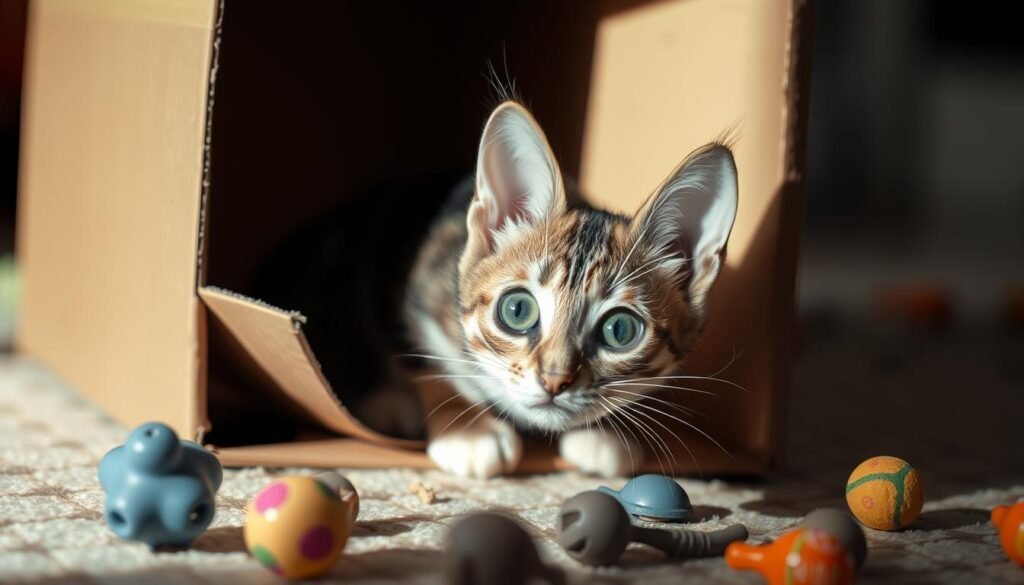Ever wonder what your cat does when you’re not there? Let’s explore the secret lives of cats. We’ll look at their fascinating behaviors when they’re alone. From their independent nature to their territorial adventures, we’ll dive into their hidden world.

What do cats do when we leave? Do they just sleep, or is there more? Get ready to discover the amazing secrets of cats. We’ll challenge what you think about these mysterious animals.
Understanding Your Cat’s Independent Nature
Cats are known for being independent, thanks to their history as solitary hunters. This trait makes them different from many pets that need constant attention. By understanding the solitary existence of cats, owners can appreciate their unique personalities.
Benefits of Solitary Existence
Cats use their alone time to recharge and practice their hunting instincts. This time helps them stay true to their independent cat nature. They also engage in activities like whisker workouts and scent-marking to feel secure.
Exploring Territorial Behaviors
Understanding a cat’s territorial behaviors helps us see their need for safety. Cats show their feline socialization in subtle ways, like seeking laps and purring. Recognizing these signs helps owners create a peaceful home for their cat.
“Cats are considered more independent than dogs, a study by the University of Lincoln suggests.”
Even though cats love their alone time, they also crave social interaction. Finding the right balance between giving them space and companionship is crucial for their happiness and well-being.
Debunking Common Myths About Cat Behavior
Cats have long been misunderstood, with many myths about their behavior. By separating fact from fiction, we can appreciate their complex communication and emotional needs. Let’s explore some of the most prevalent cat behavior myths and uncover the truth behind them.
One myth is that cats are aloof and don’t care about humans. But cats are social animals that form strong bonds with their owners. They show love in subtle ways, like slow blinks or head butts. Their desire for companionship is clear. Cats can feel attachment, happiness, and even jealousy.
Another myth is that cats can’t communicate their needs well. But cats have a complex way of talking to us through vocalizations, body language, and scent marking. From meows to tail twitches, cats tell us when they’re hungry, tired, or need attention.

It’s important to debunk these myths to strengthen the bond between cats and their owners. By understanding feline behavior and communication, we can give our cats the care and attention they deserve.
The Secret Lives of Cats: What They Really Do Alone
When cats are left alone, they show us their secret lives. They sleep a lot, up to 18 hours a day. They also explore their surroundings in fun ways. These activities are often hidden from us.
Sleeping and Resting Patterns
Cats love to sleep a lot. Dr. Sarah Brown says they sleep efficiently to save energy. They take naps and then play and explore.
Playful Exploration Activities
When awake, cats play and explore. They chase toys and climb. These activities keep them mentally and physically fit.
Knowing about cats’ secret lives helps us care for them better. It strengthens our bond and makes them happier and healthier.

“Cats have a fascinating world of their own when we’re not looking. From their extensive sleep patterns to their playful exploration, understanding their secret lives can help us create a better environment for our feline friends.”
Exploring the Neighborhood: Cats as Adventurers
Cats love to explore and go on adventures. They enjoy climbing trees, checking out gardens, and meeting other cats. These activities are great for them, providing exercise, mental fun, and a chance to be their adventurous selves. This part talks about the good things that happen when cats get to explore outside safely.
Letting cats explore outside is good for them. It helps them stay active, which makes them happy and less stressed. They also get to learn new things and solve problems, making them more interesting and fun to be around.
- Cats have up to 200 million odor senses, compared to an average pet owner who has 5 million odor senses, allowing them to detect scents up to 4 miles away.
- Cats have 32 muscles in their ears compared to humans who have 6, enabling them to tune into different sounds all around them.
- Cats can typically travel 0.2-0.5 miles when lost, but in some cases, they can travel up to 80 miles to find their way home, showcasing their remarkable navigation abilities.
Exploring outside is also good for a cat’s mind. They can make friends with other cats and feel part of a community. Being in nature also helps them relax and feel better.
“Pets can decrease stress, improve heart health, and help with emotional and social skills in children. Owning an adventure cat can give a sense of purpose, fulfillment, and meaning in life, boosting self-esteem and confidence.”
But it’s important to make sure cats are safe when they go outside. Owners should think about their cat’s age, health, and personality. They should also check if the area is safe for cats.

By letting cats explore, owners can make their lives better too. They get to see their cats happy and active. It’s a great way to spend time together and make memories.
The Role of Territory in a Cat’s Life
Cats are naturally territorial. It’s key for owners to understand their need for personal space. They mark their territory and show dominance in many ways.
Cats use scent markers to navigate their environment. They do this to establish their claim. Recognizing their territorial needs helps reduce stress and conflicts, making a peaceful home for all.
- Cats use scent markers, such as urine and gland secretions, to claim their territory and communicate their presence to other felines.
- In multi-cat households, cats may engage in territorial disputes over resources like food, water, and litter boxes, leading to potential conflicts and stress.
- Proper resource management, including providing separate feeding stations and litter boxes, can help reduce tension and promote a peaceful coexistence among cats sharing the same living space.
“Cats are not just pets, but complex beings with intricate social and behavioral needs. Understanding their territorial instincts is the key to creating a harmonious living environment for both you and your furry companion.”
By acknowledging a cat’s territory and addressing their needs, owners can strengthen their bond. This creates a stress-free, harmonious home for everyone.

Uncovering the Truth Behind Cat Napping
Cats love to sleep, often up to 18 hours a day. But why do they sleep so much? Let’s look into cat napping and the sleep needs of kittens, adult cats, and seniors. We’ll also see how their sleep benefits them.
How Much Sleep Do Cats Need?
Kittens sleep a lot, 16-20 hours a day. Adult cats sleep 12-16 hours. Senior cats need 14-18 hours of sleep. This shows how cats’ sleep needs change as they grow older.
Benefits of Sleeping for Cats
Cats sleep a lot for good reasons. It helps them stay agile and hunt well. Sleep also helps their brains work better, keeping memories sharp. A good night’s sleep is key for their health and happiness.
Learning about cat napping shows us how special their sleep needs are. By understanding cat sleep requirements, cat napping behaviors, and feline sleep health, we can help our cats live better lives.

“Cats may sleep up to 18 hours a day, but when they’re awake, they make the most of it.” – Unknown
Feeding Habits: Cats and Their Secret Meals
Cats are known for being independent, but their eating habits can be a mystery. Even their owners might not know everything about their pets. These curious animals find ways to get extra food beyond their regular meals.
How Cats Might Get Extra Food
Cats are good at finding extra food, like visiting neighbors or digging through trash. This behavior, called scavenging for additional food, is common. It’s often due to boredom, stress, or their natural hunting instinct.
Some cats even catch small animals like birds or mice to eat. While it might seem okay, it can cause weight gain and health problems if not stopped.
Impacts of Overfeeding
Overfeeding cats can lead to serious health issues, like obesity. This is a big problem because it can cause joint pain, diabetes, and breathing problems. It’s important to feed them right to keep them healthy.
To keep your cat healthy, feed them regularly and watch how much they eat. Also, make sure they get enough exercise and playtime. This helps prevent obesity and keeps them active and happy.

“Maintaining a healthy weight is essential for a cat’s well-being, and it starts with understanding their unique feeding habits.”
Socializing with Other Cats: What Happens Outside?
Cats are often seen as solitary, happy to stay in their own space. But when they go out, they enter a world of social interaction. By understanding cat social behavior and cat body language, we can see how cats connect in their communities.
In a multi-cat household, watching your cats interact shows their social order and how they communicate. They use subtle signs like paw-taps and scent-marking. These signals show their feelings and balance between being alone and being together.
“Cats are social creatures, despite their reputation for aloofness. They form intricate relationships with other felines, and these interactions can reveal a great deal about their inner lives.”
Outside their homes, cats meet new cats. Their cat body language tells us about their comfort, confidence, and territory claims. Watching these meetings helps us understand their social lives, both at home and out.

Understanding cat social behavior and multi-cat household dynamics helps pet owners care for their cats better. This knowledge strengthens the bond between humans and cats. It also keeps peace in a home with many cats.
Purr-ting Thoughts
We’ve explored the secret lives of cats, revealing what lies beneath their calm exterior. We’ve learned about their independent nature, territorial instincts, and how they sleep and eat. This knowledge helps us create a better home for our cats.
Cats are more than just pets; they have their own way of communicating. They use sounds, body language, and scent to talk to us. Understanding their emotional lives and giving them space can make our bond stronger. This way, we can make sure they are happy and healthy.
This journey has given us valuable insights into cat behavior. With this knowledge, we can make our homes more interesting for them. We can also build stronger relationships with our cats. Let’s keep learning about cats and celebrate their amazing qualities.





